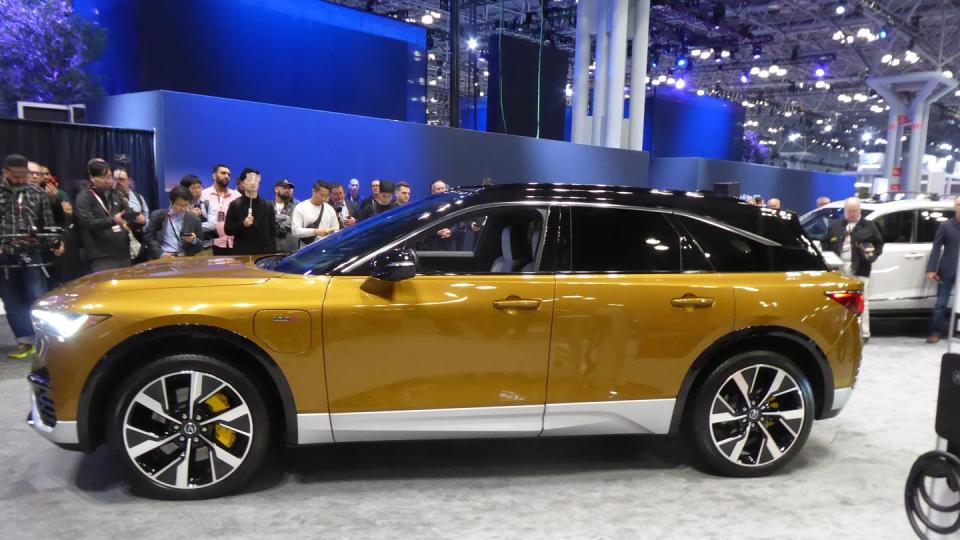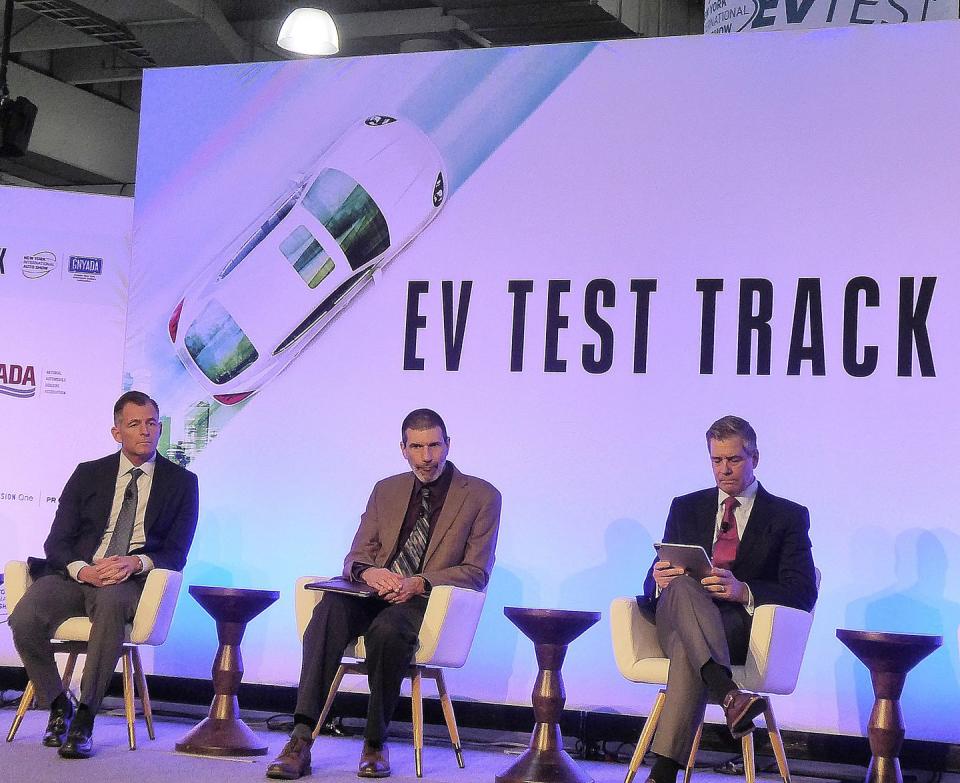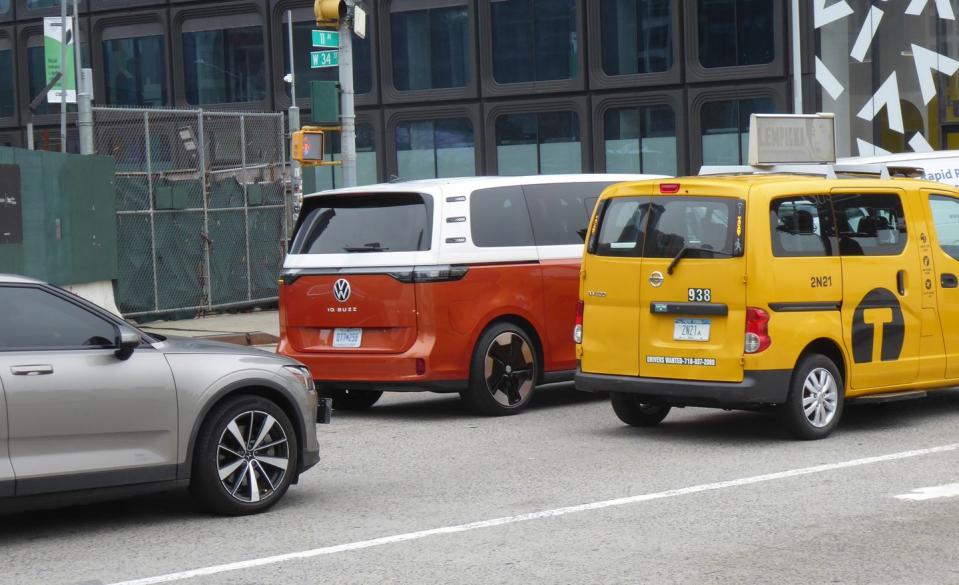Goldilocks Finds the Current EV Market Too Hot, Too Cold, and Just Right

NADA’s Mike Stanton says his organization is highly skeptical that consumers will adopt EVs anywhere near the levels required by the latest EPA rules.
Automaker lobbyist John Bozzella sees the automotive future as fully electric, without question, and says President Biden’s adjustments were needed to “give EV demand more time to kick in.
Climate activist Dan Becker thinks the EPA’s final rules are, well, too cold, and will cede EV market share to Chinese manufacturers.
At a recent New York International Auto Show forum, Mike Stanton, president of the National Automobile Dealers Association, said the Environmental Protection Agency rules for electric cars, though relaxed from initial proposals, are “not attainable, and don’t fit consumer demand.” He added that “Americans don’t like to be told what to do” and that “the car is a symbol of freedom.”
In a statement to Autoweek, Stanton said the Biden administration’s final rules remain “too aggressive.” He said, “Our experience working with consumers every day makes us highly skeptical that consumers will adopt EVs anywhere near the levels required. The charging infrastructure is not ready, the current incentives are not sufficient, and high EV prices will price out millions of consumers, particularly low-income Americans, from the new-car market.”
At the same auto show event, John Bozzella, president and CEO of the Alliance for Automotive Innovation, took a more moderate tone. Representing automakers, he said simply that “there’s no question that the future is electric,” but added that the growing EV market is “spiky,” and that Biden’s adjustments were needed to “give EV demand more time to kick in.
What automakers are trying to do is exponentially harder than what was done before.” Moderating the pace of EV adoption between 2027 and 2030 was “the right call,” Bozzella said.
To borrow from the Three Bears, Stanton and the dealers say the EPA’s EV porridge is too hot, and Bozzella and at least some of his member automakers think it’s just right. But another voice, Dan Becker, director of the Center for Biological Diversity’s Safe Climate Transport Campaign, thinks those final rules are, well, too cold, and will cede EV market share to the Chinese.
“If American manufacturers fail to make EVs, then nobody should be surprised that [leading Chinese EV producer] BYD decides to sell to the American market and takes jobs and profits back to China,” Becker said. “The Chinese will build factories in Canada, in Mexico, and wherever they can. It’s not doing Detroit a favor to help its automakers not make EVs.”

Indeed, after BYD, now the world’s leading EV producer, said it would build a plant in Mexico, protectionist pressure started heating up. BYD said the Mexican EVs aren’t headed to the US, but many politicians and the Alliance for American Manufacturing trade group are skeptical. The Alliance called for “exclusionary tariffs on all Chinese automobile imports to the United States, including both electric vehicles and internal-combustion engine vehicles.”
Donald Trump recently said, “Biden’s all-electric mandate is by very stupid people. They don’t go far, they cost too much, and they’re all going to be made in China.”
Is it possible that a combination of protectionist policies and relaxed (or no) EPA rules would increase the chances that the US EV market will be dominated by the Chinese? It seems likely. But the alarmist reports about Chinese EVs may be a bit premature, says Sam Abuelsamid, principal analyst for transportation and mobility at Guidehouse Insights.
“The Chinese automakers, while trying to expand outside China, have been focusing more on Europe and Latin America,” Abuelsamid said. “There’s a lot more immediate opportunity for them in those markets. I do think we’ll see the Chinese brands trying to break in, but it’s not imminent. I think it will happen near the end of the decade.” Abuelsamid also points out that Chinese EVs will have to be built to US safety standards, and that means they’ll likely no longer have the eye-popping low prices seen on EVs in China and Mexico.
The slowing growth of EV sales in the US has made headlines, giving ammunition to naysayers. But it’s not a massive slowdown: EVs broke global sales records in 2023, and in the US there was an almost 50% sales increase year over year from 2022—to 1.1 million units. Bloomberg predicts a smaller 32% EV sales increase in 2024. “What business person wouldn’t give their eye teeth for half that rate of sales growth?” Becker said.
“EV sales broke a million for the first time,” Katherine Garcia, director of the Sierra Club Clean Transportation for All Campaign, told Autoweek. “That’s an accomplishment—it’s record setting.”
The Sierra Club published a 2023 report that found 66% of the auto dealerships surveyed had no EVs for sale on their lots. With supply chains still hindered, the report said 44% of those car-less dealers would have offered EVs if they’d been able to get them.
The availability issue, the report said, was worst in the Midwest, but not great elsewhere. With many new models coming out, an easing of the supply problems, and greater visibility for EVs, the picture is likely to have improved somewhat since the 2023 report’s research was done.
Garcia said despite NADA’s skepticism, some dealers are supportive of the federal and state incentives and “are eager to sell EVs.” She said that Sierra’s initiatives are helping manufacturers educate their dealers about the benefits of driving EVs, answer questions about the charging infrastructure, and explain the available subsidies. Similarly, advocacy group Plug In America operates the PlugStar EV Vehicle Sales Training campaign.

“There’s a lot of activity and movement around EVs, and plenty of interest at the New York auto show,” Rebecca Lindland, senior director of industry data and insights at Cars Commerce, told Autoweek. “There’s twice as many EVs in the market as there were two years ago. But the automakers are struggling a bit with consumer adoption, which is why we saw the relaxation of the regulations.”
The slowing growth is certainly real, but it’s manifesting in unusual ways, including price cuts that benefit consumers who’ve had a hard time finding affordable EVs—and a healthier used market.
According to Cars Commerce’s February insight report, “New and used EVs are also experiencing yin and yang, as demand for new EVs continues to slow while interest in used EVs continues to grow. We’re seeing OEMs recalibrating their EV strategy, exploring hybrids and fuel-efficient gas options as new EVs sit on dealer lots longer.”
Lindland said interest in plug-in hybrids is high, because “people can get used to plugging in without making a full commitment to electric only. Just as they had to get used to plugging in phones, they have to get used to plugging in cars.”
And they need to drive them. The auto show addresses this with an EV test track that has been quite popular. “First-weekend ridership [at the track] is up 78% this year compared to the track’s relaunch in 2022,” NYIAS said. Participating automakers include Cadillac, Chevrolet, Ford, Kia, Lexus, Lucid, Nissan, and Volkswagen. Hyundai incorporated an indoor track at its stand. The NY auto show ends this Sunday.
At the show’s EV panel, Elizabeth Krear, vice president of EV practice at JD Power, said only 23% of buyers intend an EV to be their next car, but interest goes up 50% if they ride in one. JD Power said in March the EV market share will reach 12.4% in 2024, up from 7.6% last year. That’s a 63% gain, but down 0.8% from Power’s original projection.
Cox Automotive is bullish on the future for electrified vehicles. It said in its January forecast that it sees a path for EVs, hybrids, and plug-in hybrids to attain “almost 24% of the market, with EVs alone accounting for more than 10% of total sales.”
Do you consider auto shows, whether in the US or overseas, an important tool to boost EV sales? Please comment below.

 Yahoo Autos
Yahoo Autos 